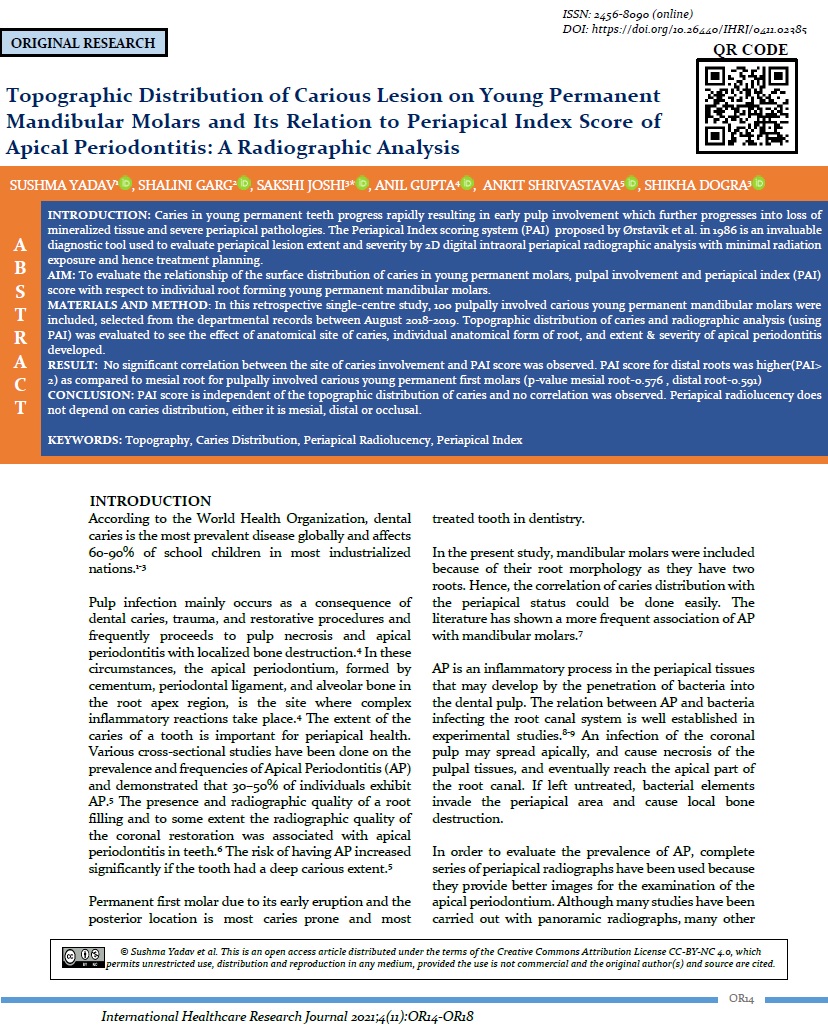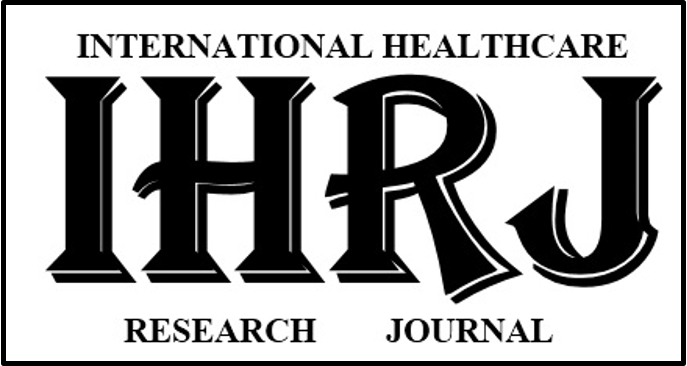Topographic Distribution of Carious Lesion on Young Permanent Mandibular Molars and Its Relation to Periapical Index Score of Apical Periodontitis: A Radiographic Analysis
Abstract
INTRODUCTION: Caries in young permanent teeth progress rapidly resulting in early pulp involvement which further progresses into loss of mineralized tissue and severe periapical pathologies. The Periapical Index scoring system (PAI) proposed by Ørstavik et al. in 1986 is an invaluable diagnostic tool used to evaluate periapical lesion extent and severity by 2D digital intraoral periapical radiographic analysis with minimal radiation exposure and hence treatment planning.
AIM: To evaluate the relationship of the surface distribution of caries in young permanent molars, pulpal involvement and periapical index (PAI) score with respect to individual root forming young permanent mandibular molars.
MATERIALS AND METHOD: In this retrospective single-centre study, 100 pulpally involved carious young permanent mandibular molars were included, selected from the departmental records between August 2018-2019. Topographic distribution of caries and radiographic analysis (using PAI) was evaluated to see the effect of anatomical site of caries, individual anatomical form of root, and extent & severity of apical periodontitis developed.
RESULT: No significant correlation between the site of caries involvement and PAI score was observed. PAI score for distal roots was higher(PAI> 2) as compared to mesial root for pulpally involved carious young permanent first molars (p-value mesial root-0.576 , distal root-0.591)
CONCLUSION: PAI score is independent of the topographic distribution of caries and no correlation was observed. Periapical radiolucency does not depend on caries distribution, either it is mesial, distal or occlusal.
Downloads
References
Hassan A, Khan JA, Ali SA. Caries Susceptibility of Proximal Surfaces in Permanent First Molars: A Cross Sectional Survey. JIIMC 2019;14(1):38-42.
Nazir MA, Bakhurji E, Gaffar BO, Al-Ansari A, Al-Khalifa KS. First Permanent Molar Caries and its Association with Carious Lesions in Other Permanent Teeth. J Clin Diagn Res. 2019;13(1): ZC36-ZC39. https://doi.org/10.7860/JCDR/2019/38167.12509
Srinath S, Somasundaram J. Dimensions of Pulp Chamber and Furcal Dentin in Mandibular First Molar in South Indian Population-A Radiographic Study. J Pharm Sci Res. 2017;9(7):1106.
Abuaffan AH, Hayder S, Hussen AA, Ibrahim TA. Prevalence of dental caries of the first permanent molars among 6-14 years old Sudanese children. Indian J Dent Educ. 2018;11(1):13-6.
Kirkevang LL, Væth M, Hörsted‐Bindslev P, Bahrami G, Wenzel A. Risk factors for developing apical periodontitis in a general population. Int Endod J. 2007;40(4):290-9.
Eriksen HM, Kirkevang LL, Petersson K. Endodontic epidemiology and treatment outcome: general considerations. Endodontic Topics 2002;2(1): 1–9. https://doi.org/10.1034/j.1601-1546.2002.20101.x
Buckley M, Spаngberg LS. The prevalence and technical quality of endodontic treatment in an American subpopulation. Oral Surgery, Oral Medicine, Oral Pathology, Oral Radiology, and Endodontology. 1995;79(1):92-100.
Möller ÅJ, Fabricius L, Dahlen G, Ohman AE, Heyden GU. Influence on periapical tissues of indigenous oral bacteria and necrotic pulp tissue in monkeys. Eur J Oral Sci. 1981;89(6):475-84.
Kakehashi S, Stanley HR, Fitzgerald RJ. The effects of surgical exposures of dental pulps in germ-free and conventional laboratory rats. Oral Surg Oral Med Oral Pathol. 1965;20(3):340-9.
Maslamani M, Behbahani J, Mitra AK. Radiographic evaluation and predictors of periapical lesions in patients with root-filled and non root-filled teeth in Kuwait. Indian J Dent Sci. 2017;9(4):237.
Marques MD, Moreira B, Eriksen HM. Prevalence of apical periodontitis and results of endodontic treatment in an adult, Portuguese population. International Endodontic Journal 1998;31(3):161-5.
Loftus JJ, Keating AP, McCartan BE. Periapical status and quality of endodontic treatment in an adult Irish population. International endodontic journal. 2005;38(2):81-6.
Venskutonis T. Periapical tissue evaluation: analysis of existing indexes and application of Periapical and Endodontic Status Scale (PESS) in clinical practice. G Ital Endod. 2016;30(1):14-21.
Orstavik D, Kerekes K, Eriksen HM. The periapical index: a scoring system for radiographic assessment of apical periodontitis. Dent Traumatol. 1986;2(1):20-34.
Terças AG, Oliveira AE, Lopes FF, Maia Filho EM. Radiographic study of the prevalence of apical periodontitis and endodontic tratment in the adult population of São Luís, MA, Brazil. J Appl Oral Sci. 2006;14(3):183-7.
Fernandes LM, Ordinola-Zapata R, Húngaro MAD, Capelozza ALA. Prevalence of apical periodontitis detected in cone beam CT images of a Brazilian subpopulation. Dentomaxillofac Radiol. 2013; 42(1): 80179163.
Nair PN. Pathogenesis of apical periodontitis and the causes of endodontic failures. Critical Reviews in Oral Biology & Medicine. 2004;15(6):348-81.
Dawson VS, Petersson K, Wolf E, Åkerman S. Periapical status of root-filled teeth restored with composite, amalgam, or full crown restorations: a cross-sectional study of a Swedish adult population. J Endod. 2016;42(9):1326-33.
Chala S, Abouqal R, Abdallaoui F. Prevalence of apical periodontitis and factors associated with the periradicular status. Acta Odontol Scand. 2011;69(6):355-9.

Copyright (c) 2021 Sushma Yadav et al.

This work is licensed under a Creative Commons Attribution-NonCommercial 4.0 International License.


